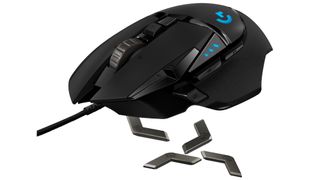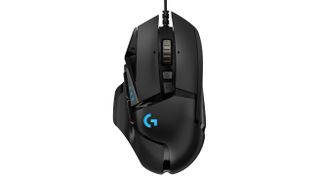The Logitech G502 is a gaming mouse that just won’t quit. It first launched nearly five years ago with a trailblazing design that reimagined outdated Logitech gaming mice and paired a new body with the best mouse sensor they could make. It was a fantastic mouse in 2013, and not much has changed: the G502 added RGB lighting a few years ago, and now, with a 2018 update, an even better sensor. With the G502 Hero, Logitech clearly decided this was an “if it ain’t broke, don’t fix it” scenario: the design of this mouse has remained untouched for five years.
Specs
DPI: 16,000
Sensor: Optical
Interface: USB
Buttons: 11
Ergonomic: Right-handed
Weight: 121 grams
The Logitech G502 is bigger and heavier than I’d recommend to most gamers, and I think Logitech and other mouse companies have surpassed its design in the years since it first released. But it remains a great gaming mouse with features few competitors offer, and with a new sensor that will keep the G502 competitive with anything released in the next five years. It’s still the best choice for a large, heavy gaming mouse around.
It weighs 121 grams, with an additional 18 grams addable with some small metal weights that fit into the bottom of the chassis. The G502 does feel solid: a good bit of that weight comes from the metal scroll wheel, which has such a wonderfully smooth and satisfying scroll feel under your finger it’ll be hard to go back to any mouse that doesn’t have it. A button below that wheel lets you switch between smooth scrolling, great for skipping through a 100 page document in a flash, and notched scrolling, more ideal for swapping weapons in an FPS. You can also click the wheel left and right for more button inputs, a rare feature these days that I love having as an option.

I generally recommend lighter mice, especially to FPS players, for how easily they’ll skate across your mouse pad and the minimal exertion it takes to twitch and click. Even the difference of 10 grams lighter is noticeable, and some gaming mice weigh in the territory of 90 grams, a huge difference. Despite its weight, moving the G502 never feels laborious, but it never disappears in your grip to feel like an extension of your hand—it definitely feels like a tool to be slung around.
You can trace the G502’s prominent arch, which is ideal for a palm grip, back to classic Logitech mice like the G500. It’s comfortable, but the steeply sloped and contoured left- and right-click buttons mean the mouse isn’t as suited for a variety of grips. The mouse clearly wants you to keep your fingers laying flat within those mouse grooves, so a more pronounced fingtertip grip isn’t as natural.
unless you really feel like you need an extra two buttons next to your index fingers, these buttons feel tacked-on
With five years of perspective, this part of the G502 feels overdesigned. There’s a strange, slightly offputting asymmetry to the left-click button being concave, scooping inward to hold your finger, while the right-click button is convex and slopes off to the right. I sometimes feel like my finger is slipping off the edge of the right-click button, and because the left-click is relatively narrow compared to most other mice, I find myself often accidentally clicking one of the two smaller buttons Logitech added to the left corner of the mouse. They’re simply too easy to press, and by default serve as a DPI switcher. Many times over the past week I’ve sent my cursor flying across the screen by accidentally pressing DPI+ instead of left-clicking.
There are plenty of solutions to this problem: rebind the button, disable its binding altogether, or simply spend long enough with the mouse to hone in my muscle memory to avoid misclicks. But unless you really feel like you need an extra two buttons next to your index fingers, these buttons feel tacked-on and more likely to cause misclicks than anything. They’re my least favorite thing about the design of the G502.

The thumb groove on the lefthand side of the mouse, on the other hand, is great, with two large, nicely clicky thumb buttons that are easy to press by rocking your thumb upwards. They’re smartly positioned to be easy to press but stay out of your way, avoiding misclicks and letting you keep a solid grip on the mouse. The G502 also has a “sniper” (aka DPI shift) button at the tip of the thumb, which you can rebind to anything, but by default is for holding down to temporarily lower your DPI for precision aiming.
I think the sniper button is another excess—for most games, a couple programmable thumb buttons will do the job—but it doesn’t get in the way if you don’t use it. Tweaking button assignments and DPI is a breeze with the G502 thanks to Logitech’s newly updated G Hub software, which is prettier and lighter weight than its previous driver utility. While it’s not quite as packed with features as some other mouse drivers out there, it strikes the right balance between functionality and simplicity.
The G502’s performance is better than it’s ever been, thanks to the new 16,000 DPI Hero sensor Logitech is also using in its high-end gaming mice. But for most people, it’ll be hard to spot any difference between the Hero sensor and the older G502’s PMW3366, which performed nearly flawlessly up to 12,000 DPI. The Hero sensor likewise has no acceleration, jitter, or other similar issues that plagued gaming mice of old. Tracking simply won’t be a problem.
For most people, the upgrade to the Hero sensor will go unnoticed, which makes the refreshed G502’s higher price a bit harder to justify. It’s the best version of this mouse you can buy today—but if you’re mainly after a heavy mouse tailor fit for a palm grip, the cheaper G502 Proteus Spectrum will still do the job with aplomb.

